
Art Gharana — 12 Mins read
Carnatic vs Hindustani Classical Music: Highlights, Differences, and Choosing the Best Style
Vocal
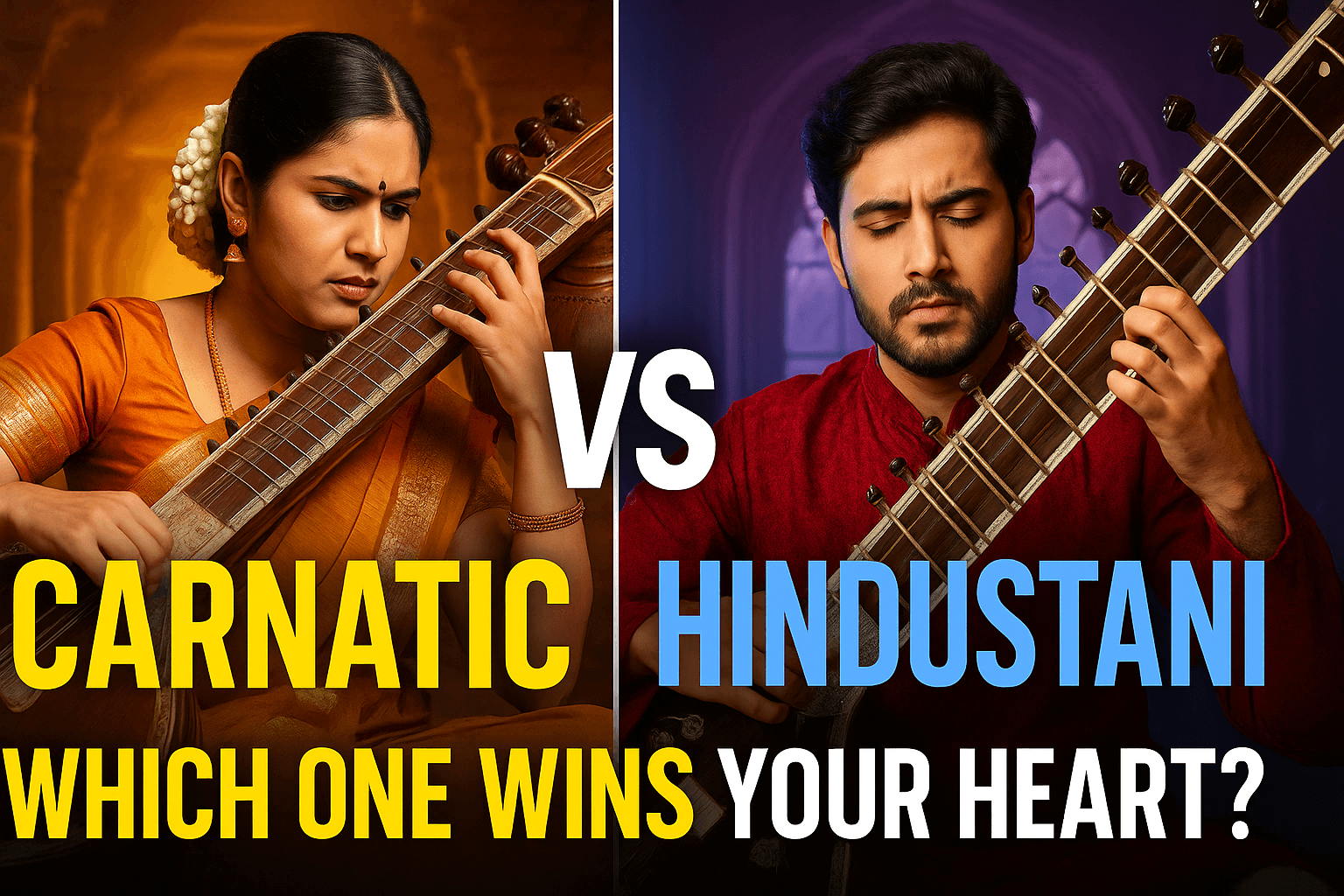 The field of Indian music styles dates back thousands of years and offers a rich tapestry of melodic and rhythmic traditions. In this vibrant world of Indian classical music traditions, there are two major branches: one known as Carnatic classical music, practiced mainly in the south, and the other called Hindustani classical music, flourishing in the north. Each stems from ancient origins yet diverges into distinct paths of expression.
The field of Indian music styles dates back thousands of years and offers a rich tapestry of melodic and rhythmic traditions. In this vibrant world of Indian classical music traditions, there are two major branches: one known as Carnatic classical music, practiced mainly in the south, and the other called Hindustani classical music, flourishing in the north. Each stems from ancient origins yet diverges into distinct paths of expression.
Exploring the world of Carnatic and Hindustani classical music means stepping into a realm where Raga and Taal in Indian music form the backbone of creative performance. Both traditions follow the concept of Shruti and Swara, the microtones and notes that build up the melodic structure. Despite the divergence in style and region, the two traditions share deep roots in ancient Indian music forms and devotional music traditions.
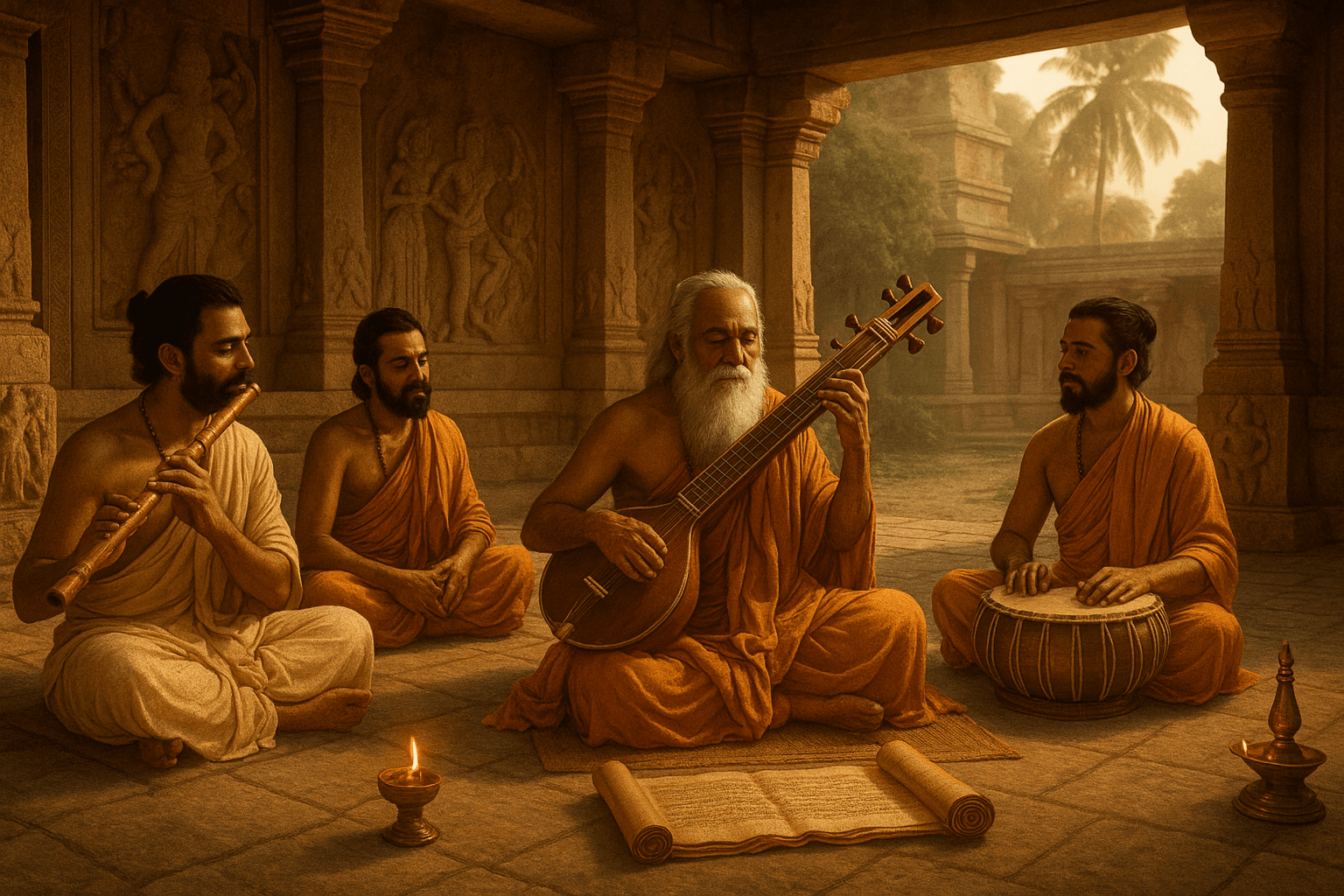 The classical music of India finds its earliest mention in texts such as the Samaveda and the Natya Shastra, where music, dance and ritual combined in sacred performance. Over centuries the traditions evolved into structured forms that included melodic frameworks (raga) and rhythmic cycles (tala). By the time the divergence between north and south crystallised, the foundations of Indian classical music traditions were well established.
The classical music of India finds its earliest mention in texts such as the Samaveda and the Natya Shastra, where music, dance and ritual combined in sacred performance. Over centuries the traditions evolved into structured forms that included melodic frameworks (raga) and rhythmic cycles (tala). By the time the divergence between north and south crystallised, the foundations of Indian classical music traditions were well established.
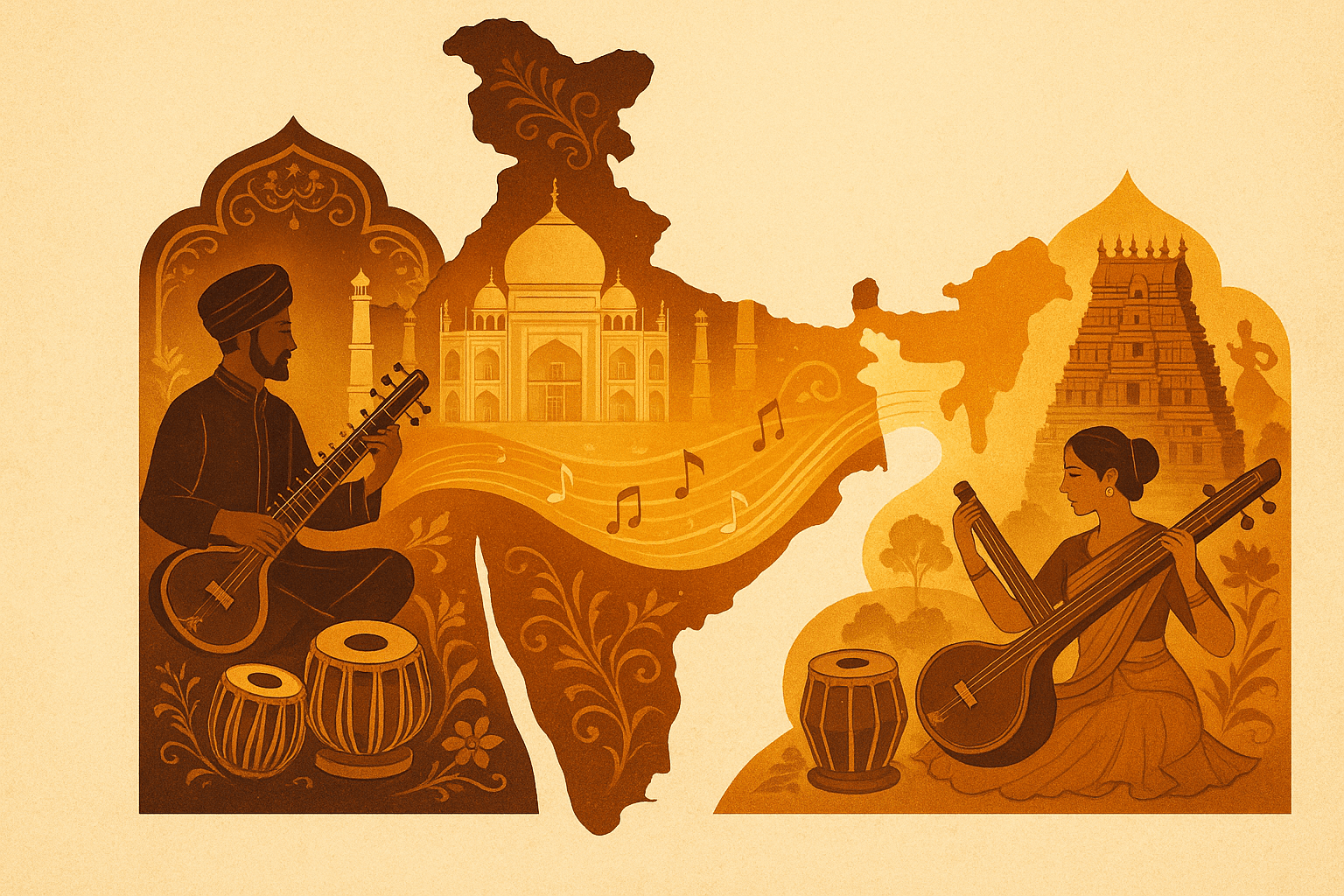 In North India, the influence of Persian and Arabic traditions via the Mughal era brought new colours to the classical idiom. This resulted in what we know as Hindustani classical music, shaped in part by the courts of the Mughals and influenced by Sufi thought. In the South, the classical stream remained more tied to temple traditions, devotional compositions and the Bhakti movement, and that led to the flourishing of Carnatic classical music. These two regional realities produced contrasting styles yet the same spirit of musical devotion.
In North India, the influence of Persian and Arabic traditions via the Mughal era brought new colours to the classical idiom. This resulted in what we know as Hindustani classical music, shaped in part by the courts of the Mughals and influenced by Sufi thought. In the South, the classical stream remained more tied to temple traditions, devotional compositions and the Bhakti movement, and that led to the flourishing of Carnatic classical music. These two regional realities produced contrasting styles yet the same spirit of musical devotion.
 What unites the two traditions of Hindustani vs Carnatic is the presence of raga—melodic frameworks that define mood and structure—and tala, the rhythmic cycles that underpin performances. Both use the concept of Bhava, the emotional expression that gives life to a performance. Even as each style developed its own vocabulary of ornamentation, improvisation and form, the shared pillars show the common ancestry and the continuing dialogue between the north and south.
What unites the two traditions of Hindustani vs Carnatic is the presence of raga—melodic frameworks that define mood and structure—and tala, the rhythmic cycles that underpin performances. Both use the concept of Bhava, the emotional expression that gives life to a performance. Even as each style developed its own vocabulary of ornamentation, improvisation and form, the shared pillars show the common ancestry and the continuing dialogue between the north and south.
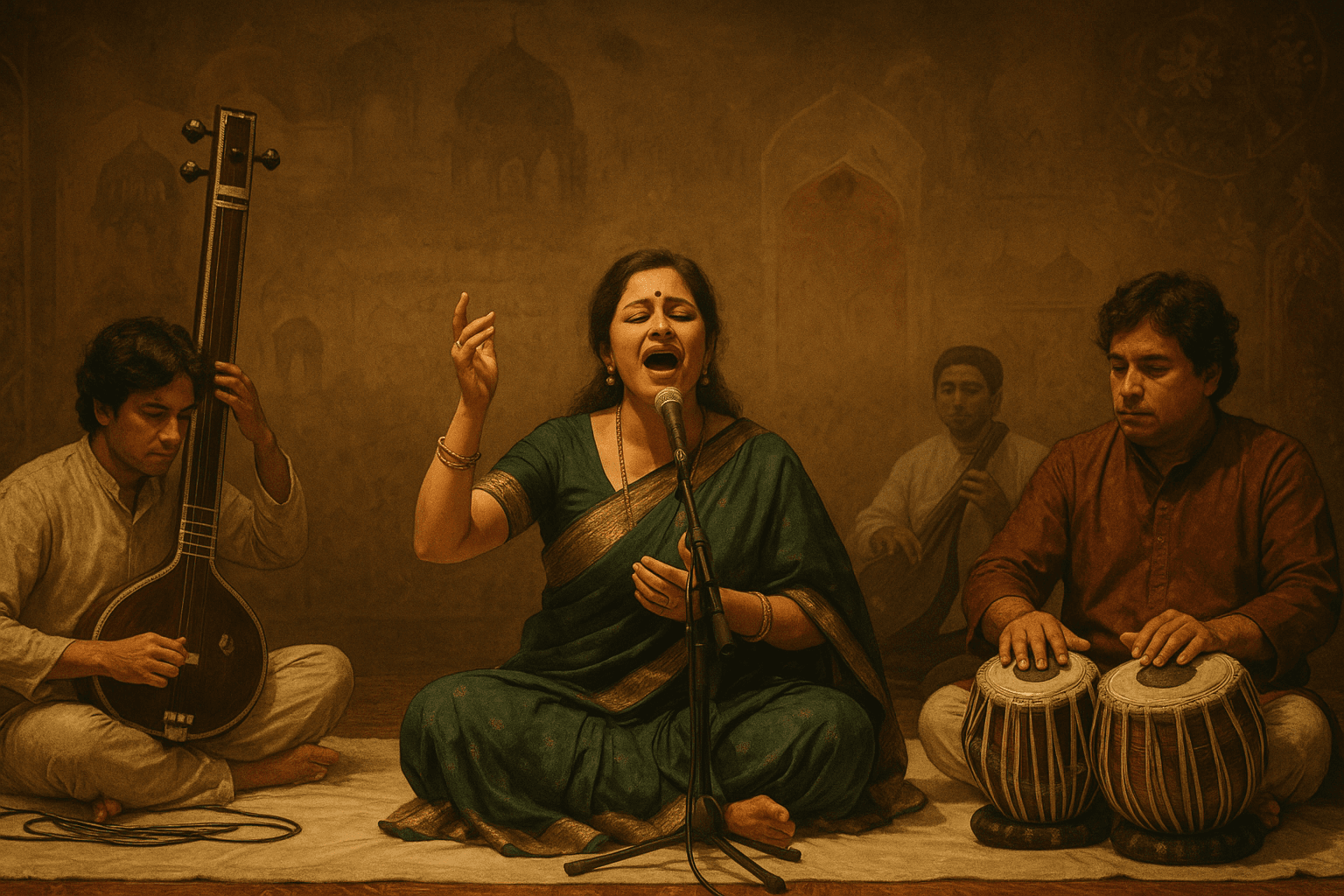 When you delve into Hindustani classical music you discover a dynamic art form influenced by centuries of intercultural exchange, where improvisation and the grandeur of the raga tradition shine. The genre is rich with historical depth, evolving from devotional roots into intricate scholarly and performative streams. Over time the Gharana tradition (schools of style) emerged, helping codify variations such as the Agra Gharana or Gwalior Gharana.
When you delve into Hindustani classical music you discover a dynamic art form influenced by centuries of intercultural exchange, where improvisation and the grandeur of the raga tradition shine. The genre is rich with historical depth, evolving from devotional roots into intricate scholarly and performative streams. Over time the Gharana tradition (schools of style) emerged, helping codify variations such as the Agra Gharana or Gwalior Gharana.
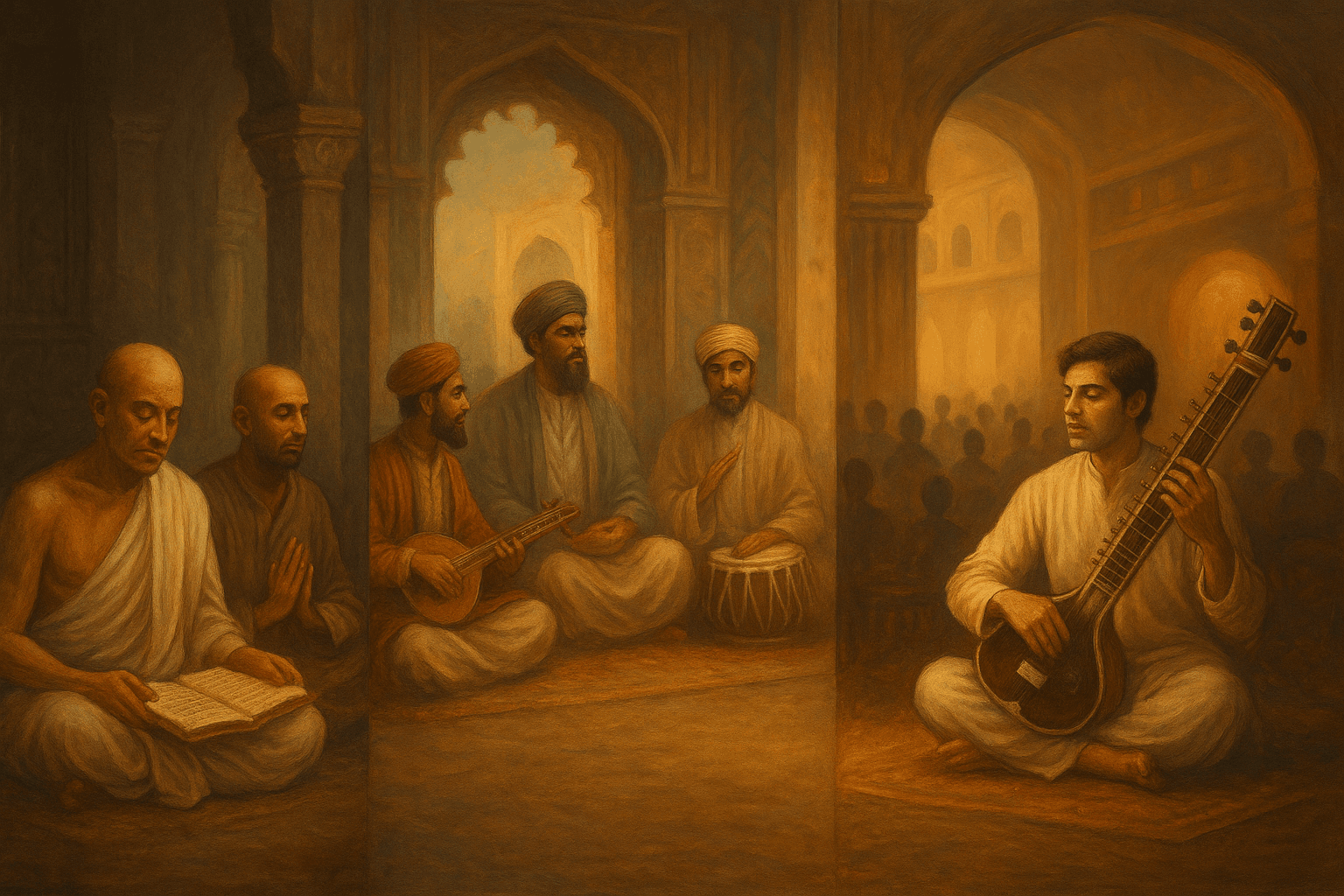 Hindustani classical music emerged from the northern plains of India and absorbed influences from Sanskritic temple traditions, folk melodies, and later Persian and Arabic stylistic elements. The evolution of Hindustani music reflects a blending of indigenous and foreign threads, where the old Vedic chants gave way to court performance, then public concert structures and global dissemination.
Hindustani classical music emerged from the northern plains of India and absorbed influences from Sanskritic temple traditions, folk melodies, and later Persian and Arabic stylistic elements. The evolution of Hindustani music reflects a blending of indigenous and foreign threads, where the old Vedic chants gave way to court performance, then public concert structures and global dissemination.
 The arrival of Islamic rulers and the cultural exchange during the Mughal era introduced Persian music philosophies and Sufism into the expression of Hindustani classical music. For example, the development of the Khayal genre owes much to these cross-cultural currents. Similarly, the folk traditions of North India contributed via simpler melodic forms that then matured into sophisticated raga explorations.
The arrival of Islamic rulers and the cultural exchange during the Mughal era introduced Persian music philosophies and Sufism into the expression of Hindustani classical music. For example, the development of the Khayal genre owes much to these cross-cultural currents. Similarly, the folk traditions of North India contributed via simpler melodic forms that then matured into sophisticated raga explorations.
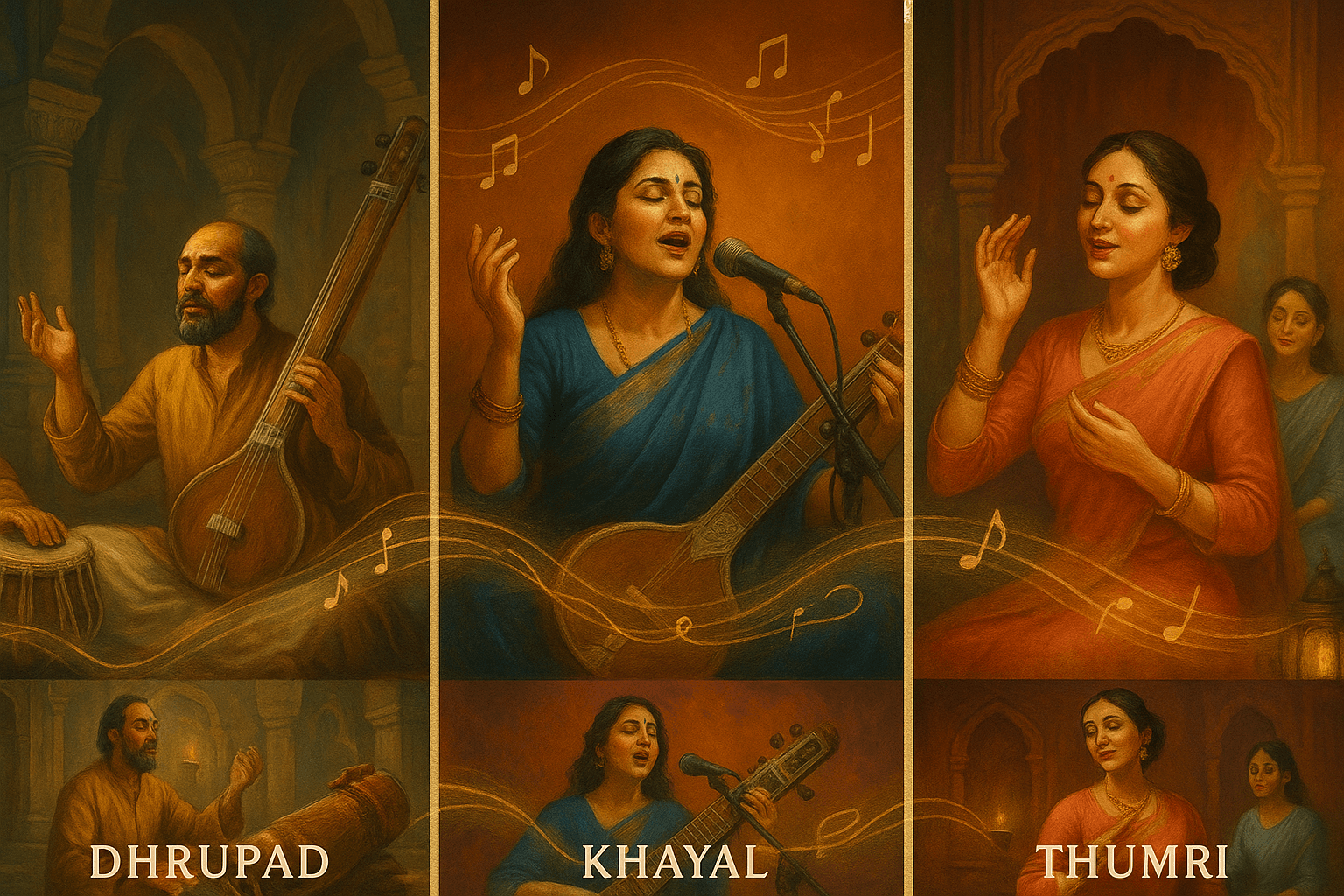
In the genre of Dhrupad one finds austere compositional lines, a meditative approach and minimal ornamentation. Its roots trace to spiritual hymns and the early manuscripts of Indian musicology. Dhrupad emphasises the structural integrity of the raga and showcases the depth of expression rather than overt virtuosity.
Khayal introduced flexibility, melody, and vivid imagination into Hindustani classical music. It allows artists to weave through the raga with expansive improvisation, vocal ornamentation, and emotional nuance. The shift from Dhrupad to Khayal marks a turning point in the history of the difference between Carnatic and Hindustani music.
Thumri is lighter, lyrical and focused on sentiment. Originally tied to the Bhakti movement, Thumri highlights romantic or devotional expression through melodic variation (vistaar), soft ornamentation, and emotional vocal shading. The interplay between bandish, abhang and lyrical nuance makes Thumri a uniquely expressive facet of Hindustani music.
 The types of Indian classical music include instrumental and vocal forms, and in Hindustani the sitar, sarod, tabla and harmonium dominate. Each instrument helps shape the sonic palette: the sitar with its resonant strings and freestyle slides, the tabla with its rhythmic complexity, and the harmonium with its sustaining chords for the voice. These tools enable the vast improvisation and melodic ornamentation that Hindustani music thrives upon.
The types of Indian classical music include instrumental and vocal forms, and in Hindustani the sitar, sarod, tabla and harmonium dominate. Each instrument helps shape the sonic palette: the sitar with its resonant strings and freestyle slides, the tabla with its rhythmic complexity, and the harmonium with its sustaining chords for the voice. These tools enable the vast improvisation and melodic ornamentation that Hindustani music thrives upon.
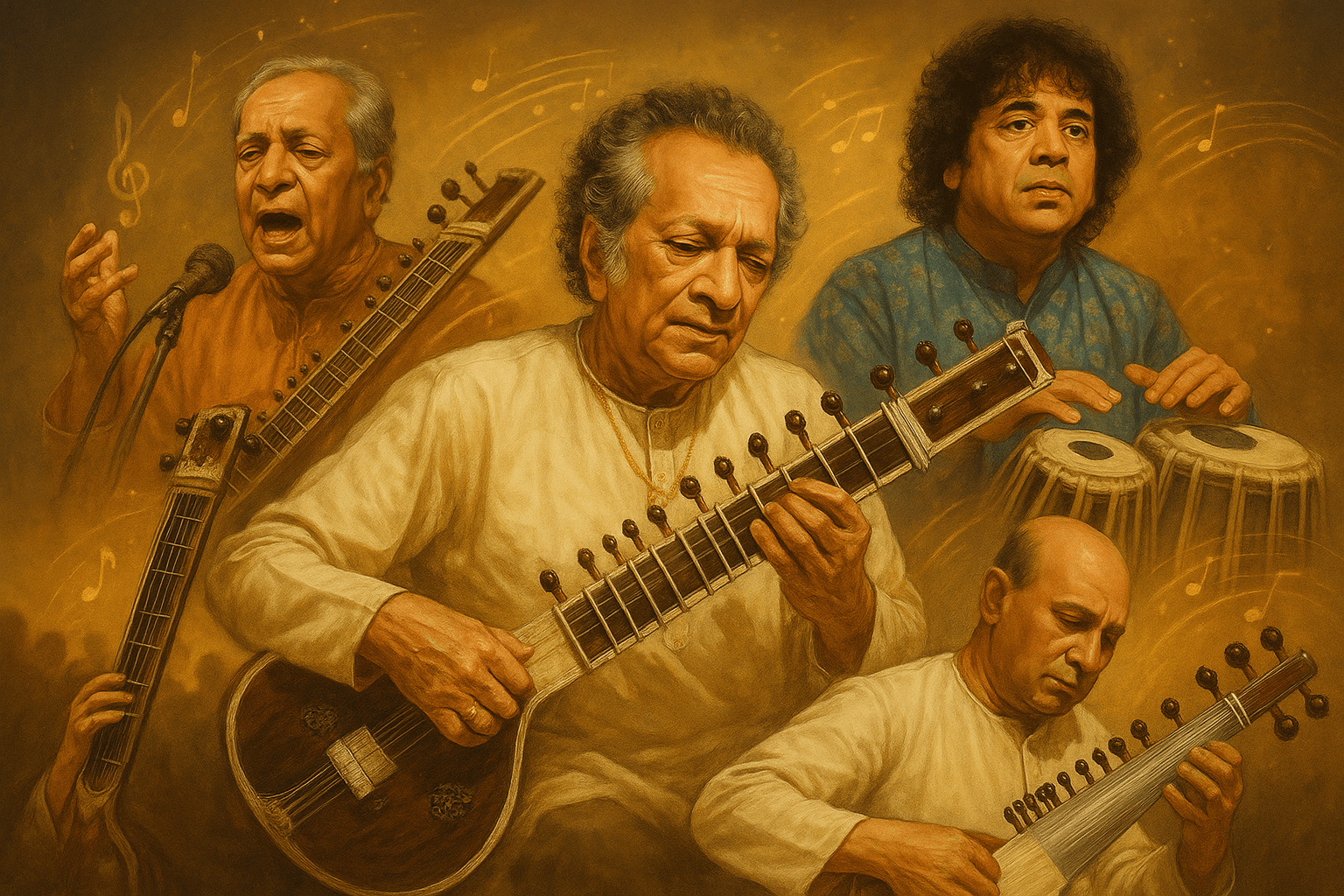 Artists such as Ravi Shankar, Bhimsen Joshi and many others created a global bridge for Hindustani classical music. They expanded the influence of Indian classical music traditions across continents. Their work honours the lineage of the Guru-Shishya Parampara while embracing modern concert formats and global audiences.
Artists such as Ravi Shankar, Bhimsen Joshi and many others created a global bridge for Hindustani classical music. They expanded the influence of Indian classical music traditions across continents. Their work honours the lineage of the Guru-Shishya Parampara while embracing modern concert formats and global audiences.
 When you explore Carnatic classical music you’ll encounter a vibrant tradition concentrated in South India, rooted in Bhakti, devotional themes and highly structured musical architecture. While improvisation is certainly present, the emphasis leans more toward predetermined compositions known as kritis, and a performance format that engages the audience with rhythmic vitality and melodic precision.
When you explore Carnatic classical music you’ll encounter a vibrant tradition concentrated in South India, rooted in Bhakti, devotional themes and highly structured musical architecture. While improvisation is certainly present, the emphasis leans more toward predetermined compositions known as kritis, and a performance format that engages the audience with rhythmic vitality and melodic precision.
 Carnatic music evolved in Tamil Nadu, Andhra Pradesh, Karnataka and Kerala, drawing from temple rituals, royal patronage, the Bhakti movement and the dynamics of South Indian culture. Its lineage stretches back to devotional music practices that gradually formalised into systematic teaching and sophisticated concert formats.
Carnatic music evolved in Tamil Nadu, Andhra Pradesh, Karnataka and Kerala, drawing from temple rituals, royal patronage, the Bhakti movement and the dynamics of South Indian culture. Its lineage stretches back to devotional music practices that gradually formalised into systematic teaching and sophisticated concert formats.
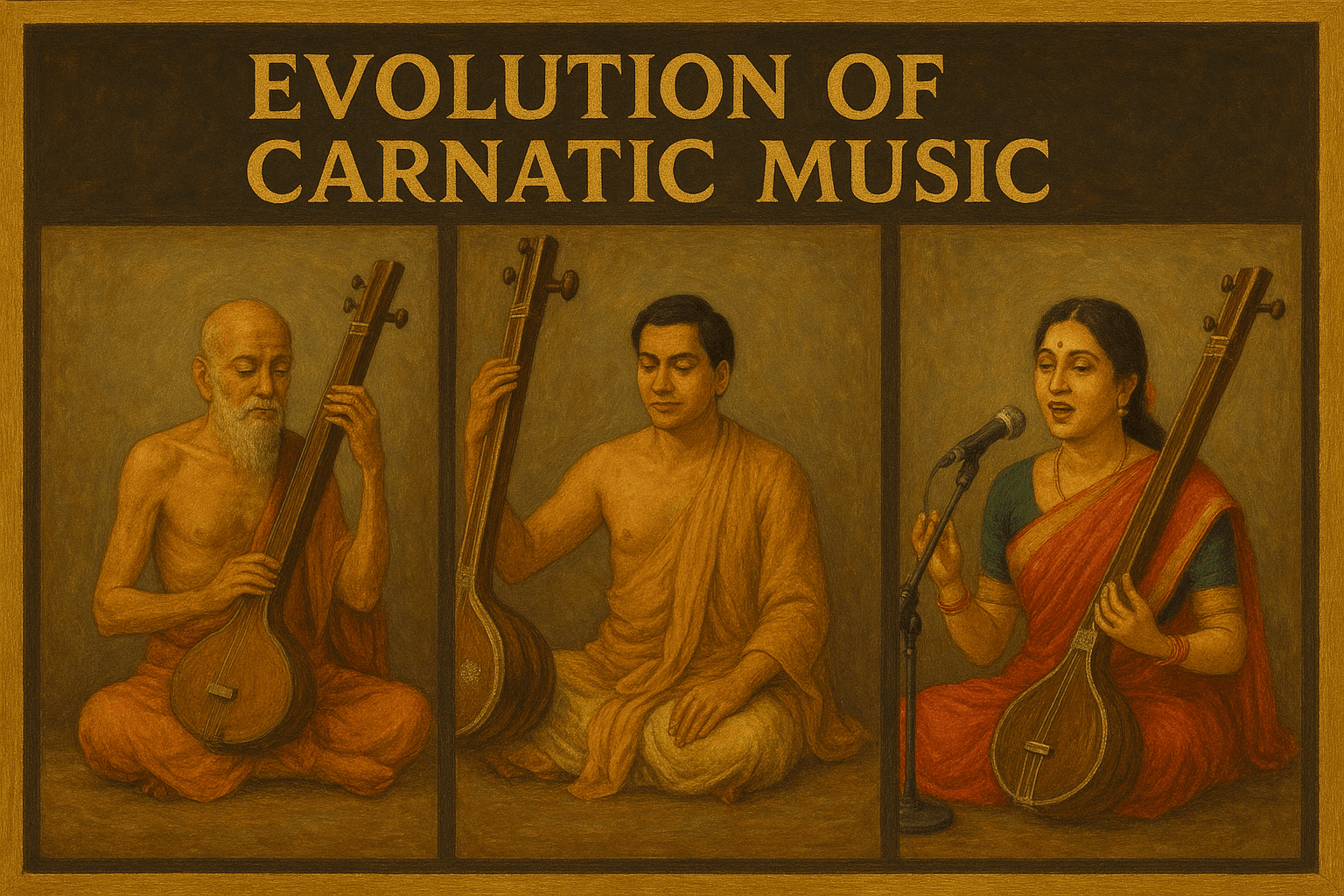 Over the centuries the tradition of Carnatic classical music solidified through the work of the trinity of composers—Tyagaraja, Muthuswami Dikshitar and Syama Sastri—who gave the repertoire of kritis, varnams and ragam-thanam-pallavi its modern shape. Through the melakarta system (72 parent ragas) and the integration of gamaka ornamentation, the Carnatic tradition preserved a deep connection to spiritual expression and theory.
Over the centuries the tradition of Carnatic classical music solidified through the work of the trinity of composers—Tyagaraja, Muthuswami Dikshitar and Syama Sastri—who gave the repertoire of kritis, varnams and ragam-thanam-pallavi its modern shape. Through the melakarta system (72 parent ragas) and the integration of gamaka ornamentation, the Carnatic tradition preserved a deep connection to spiritual expression and theory.
 In a typical Carnatic concert you will hear a varnam (warm-up piece), a kriti (main composition) and sections of improvisation like alapana and kalpanaswaram. The structure ensures both familiarity and variation, letting the artist display mastery of both composition and improvisation. The combination defines the unique Carnatic music structure that distinguishes it from Hindustani.
In a typical Carnatic concert you will hear a varnam (warm-up piece), a kriti (main composition) and sections of improvisation like alapana and kalpanaswaram. The structure ensures both familiarity and variation, letting the artist display mastery of both composition and improvisation. The combination defines the unique Carnatic music structure that distinguishes it from Hindustani.
 The lyrical content in Carnatic music often uses Sanskrit, Telugu, Tamil and Kannada languages, deeply imbued with the Bhakti movement’s devotional fervour. These musical compositions in Sanskrit and regional languages connect performer and audience in a shared spiritual experience. That devotional music foundation remains central to the Carnatic tradition.
The lyrical content in Carnatic music often uses Sanskrit, Telugu, Tamil and Kannada languages, deeply imbued with the Bhakti movement’s devotional fervour. These musical compositions in Sanskrit and regional languages connect performer and audience in a shared spiritual experience. That devotional music foundation remains central to the Carnatic tradition.
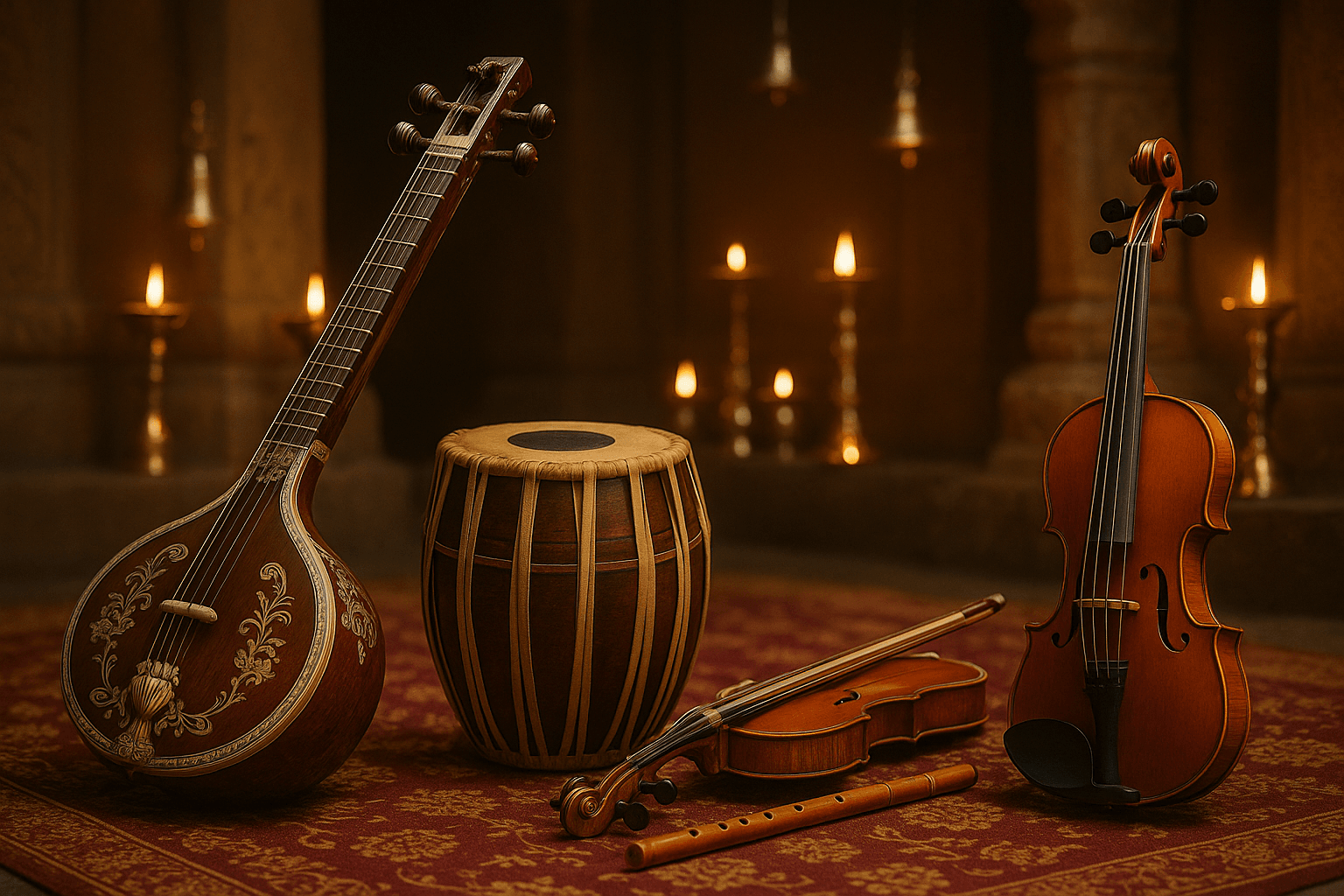 Instruments such as the veena, mridangam, violin and flute play pivotal roles in Carnatic classical music. The veena provides a lyrical and vocal-like string voice, the mridangam drives the complex rhythmic tala cycles, the violin complements the voice in a vocal style (gayaki) and the flute adds melodic beauty. Together they manifest the fine interplay of melody and rhythm in Carnatic performance.
Instruments such as the veena, mridangam, violin and flute play pivotal roles in Carnatic classical music. The veena provides a lyrical and vocal-like string voice, the mridangam drives the complex rhythmic tala cycles, the violin complements the voice in a vocal style (gayaki) and the flute adds melodic beauty. Together they manifest the fine interplay of melody and rhythm in Carnatic performance.
 These three composers are foundational figures in Carnatic music. Tyagaraja’s devotional kritis, Dikshitar’s scholarly mastery, and Syama Sastri’s rhythmic innovation defined the musical canon for generations. Their contributions exemplify the depth of Carnatic classical music and its structured approach to composition, improvisation and pedagogy.
These three composers are foundational figures in Carnatic music. Tyagaraja’s devotional kritis, Dikshitar’s scholarly mastery, and Syama Sastri’s rhythmic innovation defined the musical canon for generations. Their contributions exemplify the depth of Carnatic classical music and its structured approach to composition, improvisation and pedagogy.
 When one compares Carnatic and Hindustani classical music the richness of both styles becomes clear, as do their divergences. From vocal usage to rhythmic cycles, from raga systems to language of compositions, the contrasts highlight cultural, historical and stylistic differences. Yet underlying it all is the shared foundation of melody (raga), rhythm (tala) and emotion (bhava).
When one compares Carnatic and Hindustani classical music the richness of both styles becomes clear, as do their divergences. From vocal usage to rhythmic cycles, from raga systems to language of compositions, the contrasts highlight cultural, historical and stylistic differences. Yet underlying it all is the shared foundation of melody (raga), rhythm (tala) and emotion (bhava).
In Hindustani music vocalists often start with a slow alaap, gradually building into intricate taans and improvisations. The focus is on melodic exploration and spontaneous creation. In Carnatic classical music the emphasis is on precise execution of kritis and complex rhythmic improvisation, with vocal lines rich in gamaka and tightly integrated with tala. The style of presentation in each tradition shapes how the audience perceives and engages with the music.
 Both traditions prize improvisation in classical music but carry it out differently. Hindustani music uses alaap, alaankaar, taan and murki to ornament and weave through the raga. Carnatic music uses gamaka, kampita gamaka, neraval, and kalpanaswaram to explore the ragam’s mood within structured compositions. These vocal ornamentation techniques and melodic improvisation practices mark a key part of the contrast between Carnatic and Hindustani music.
Both traditions prize improvisation in classical music but carry it out differently. Hindustani music uses alaap, alaankaar, taan and murki to ornament and weave through the raga. Carnatic music uses gamaka, kampita gamaka, neraval, and kalpanaswaram to explore the ragam’s mood within structured compositions. These vocal ornamentation techniques and melodic improvisation practices mark a key part of the contrast between Carnatic and Hindustani music.
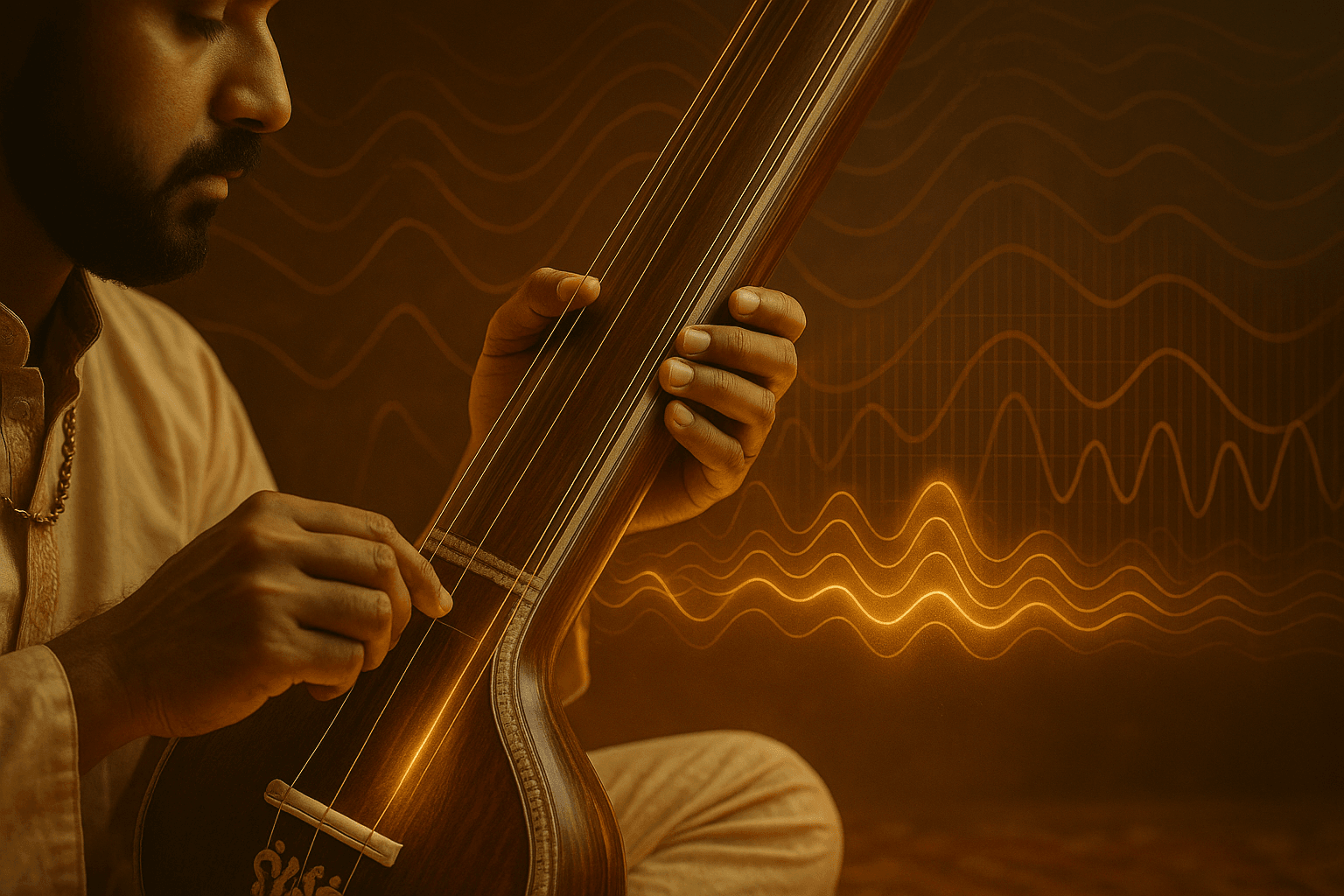 The microtones or shrutis underlying each style reveal subtle but important differences. Hindustani classical music typically uses 12 shrutis in practice, while Carnatic classical music often uses 16 shrutis and more elaborate pitch variations (vakra swara). The details of voice modulation, oscillation and pitch variation shape the texture of each tradition’s melodic expression.
The microtones or shrutis underlying each style reveal subtle but important differences. Hindustani classical music typically uses 12 shrutis in practice, while Carnatic classical music often uses 16 shrutis and more elaborate pitch variations (vakra swara). The details of voice modulation, oscillation and pitch variation shape the texture of each tradition’s melodic expression.
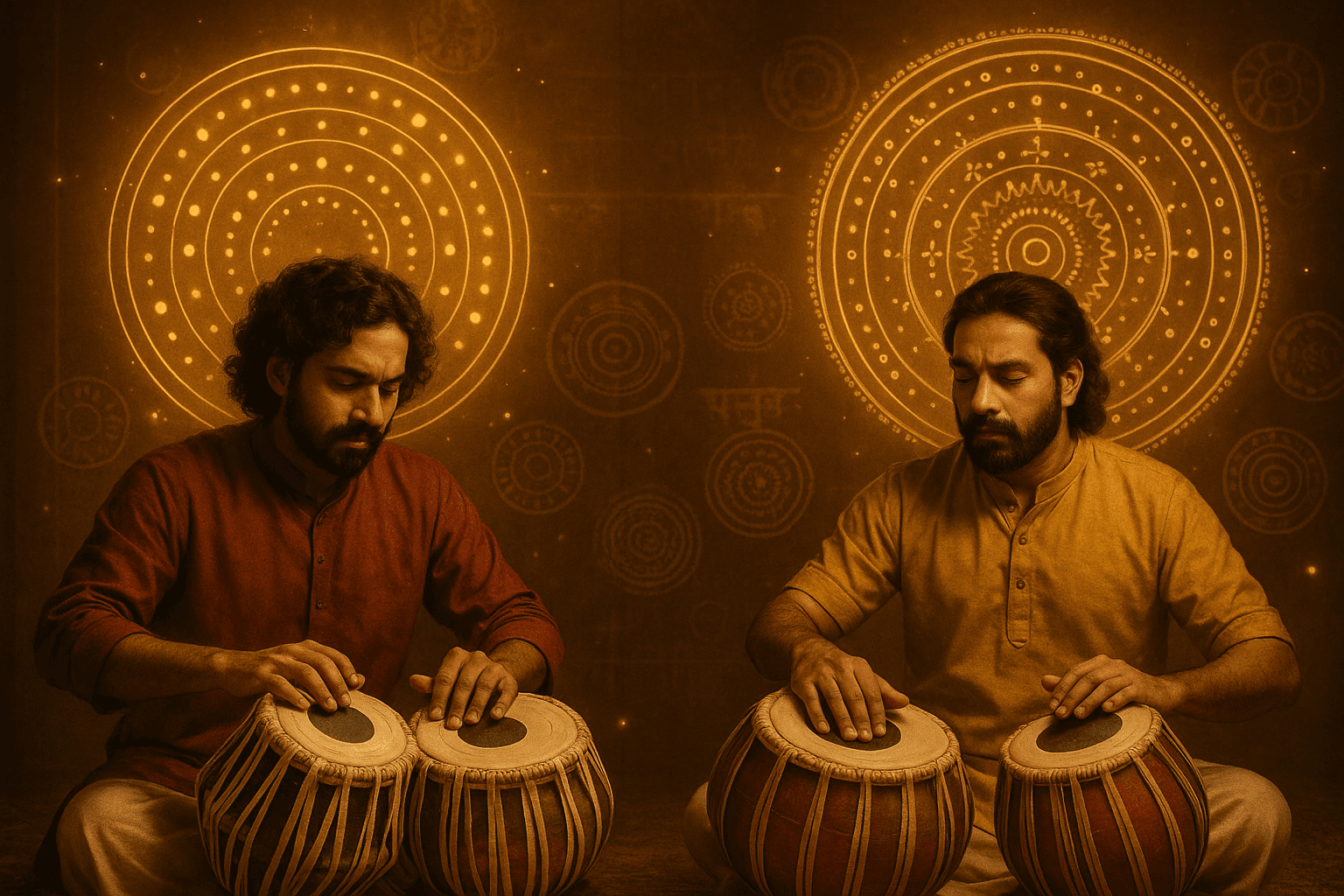 Rhythm lies at the heart of both traditions though the implementation differs. Hindustani classical music uses a rhythmic cycle (taal) with instruments such as the tabla and pakhawaj and emphasises flexible rhythmic interplay. In contrast the Carnatic tradition uses structured tala systems—such as the Adi or Rupaka—with the mridangam and theoretical frameworks grounded in the melakarta system. The difference in rhythmic complexity and presentation is vital to understanding both genres.
Rhythm lies at the heart of both traditions though the implementation differs. Hindustani classical music uses a rhythmic cycle (taal) with instruments such as the tabla and pakhawaj and emphasises flexible rhythmic interplay. In contrast the Carnatic tradition uses structured tala systems—such as the Adi or Rupaka—with the mridangam and theoretical frameworks grounded in the melakarta system. The difference in rhythmic complexity and presentation is vital to understanding both genres.
 In the concept of Gayan Samay, many Hindustani ragas are assigned specific times of day and seasons when they should be performed. Carnatic classical music typically does not strictly follow time-of-day rules. This difference reflects the historical and cultural contexts of pilgrimage, royalty and ritual that shaped each tradition.
In the concept of Gayan Samay, many Hindustani ragas are assigned specific times of day and seasons when they should be performed. Carnatic classical music typically does not strictly follow time-of-day rules. This difference reflects the historical and cultural contexts of pilgrimage, royalty and ritual that shaped each tradition.
 Hindustani music compositions often include Hindi, Urdu, Sanskrit, Braj – reflecting the northern linguistic landscape and Persian influence. Carnatic classical music uses Sanskrit, Telugu, Tamil and Kannada, reflecting South India’s linguistic heritage and devotional themes. The language of compositions thereby shapes the genre’s accessibility, poetic tone and cultural resonance.
Hindustani music compositions often include Hindi, Urdu, Sanskrit, Braj – reflecting the northern linguistic landscape and Persian influence. Carnatic classical music uses Sanskrit, Telugu, Tamil and Kannada, reflecting South India’s linguistic heritage and devotional themes. The language of compositions thereby shapes the genre’s accessibility, poetic tone and cultural resonance.
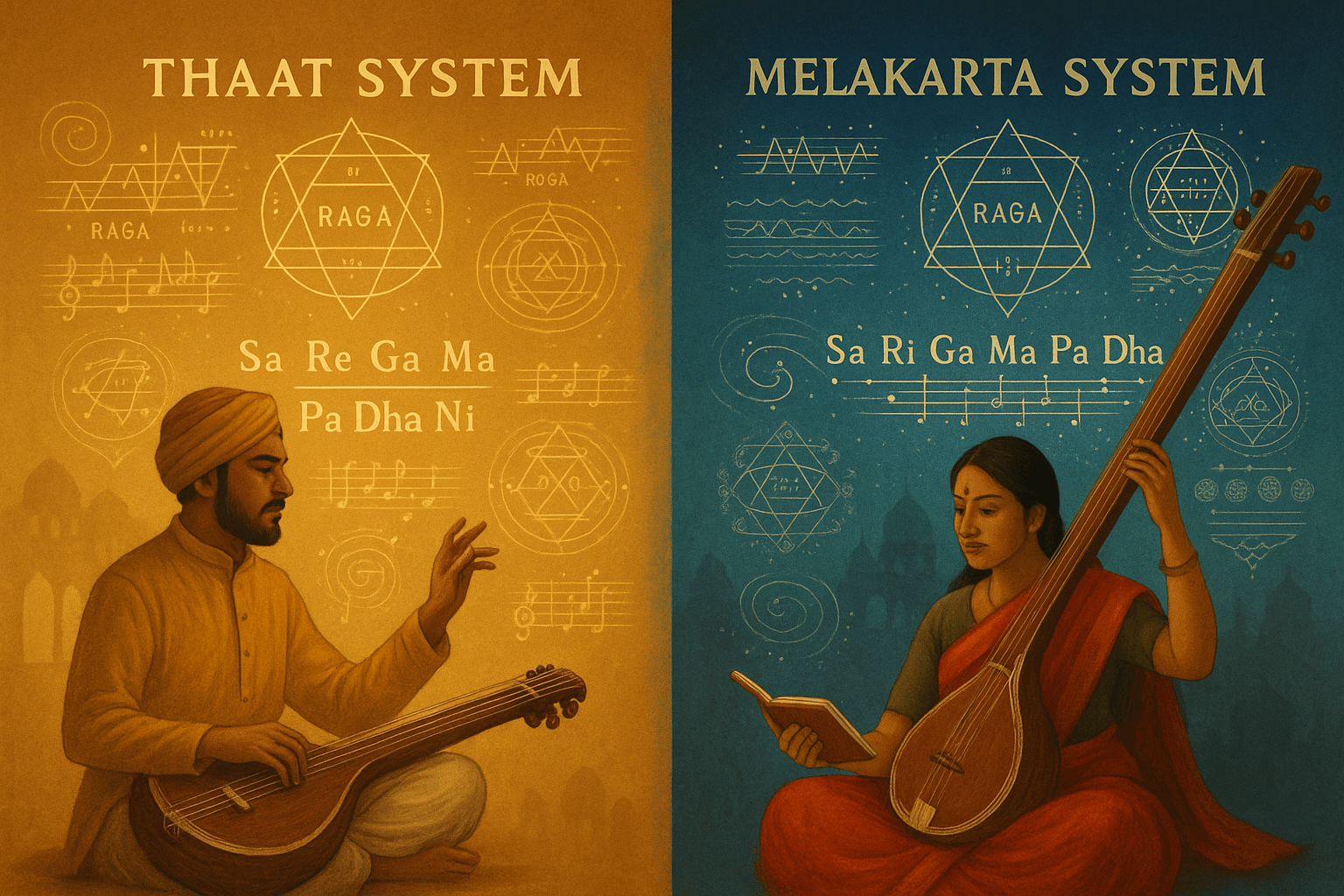 The raga classification systems differ: Hindustani music uses a set of ten thaats (parent scales) while the Carnatic tradition uses the melakarta system with seventy-two parent ragas and many janya ragas derived from them. This systematised structure in Carnatic music contrasts with the more flexible thaat-rag structure in Hindustani music and highlights a core difference between the two traditions.
The raga classification systems differ: Hindustani music uses a set of ten thaats (parent scales) while the Carnatic tradition uses the melakarta system with seventy-two parent ragas and many janya ragas derived from them. This systematised structure in Carnatic music contrasts with the more flexible thaat-rag structure in Hindustani music and highlights a core difference between the two traditions.
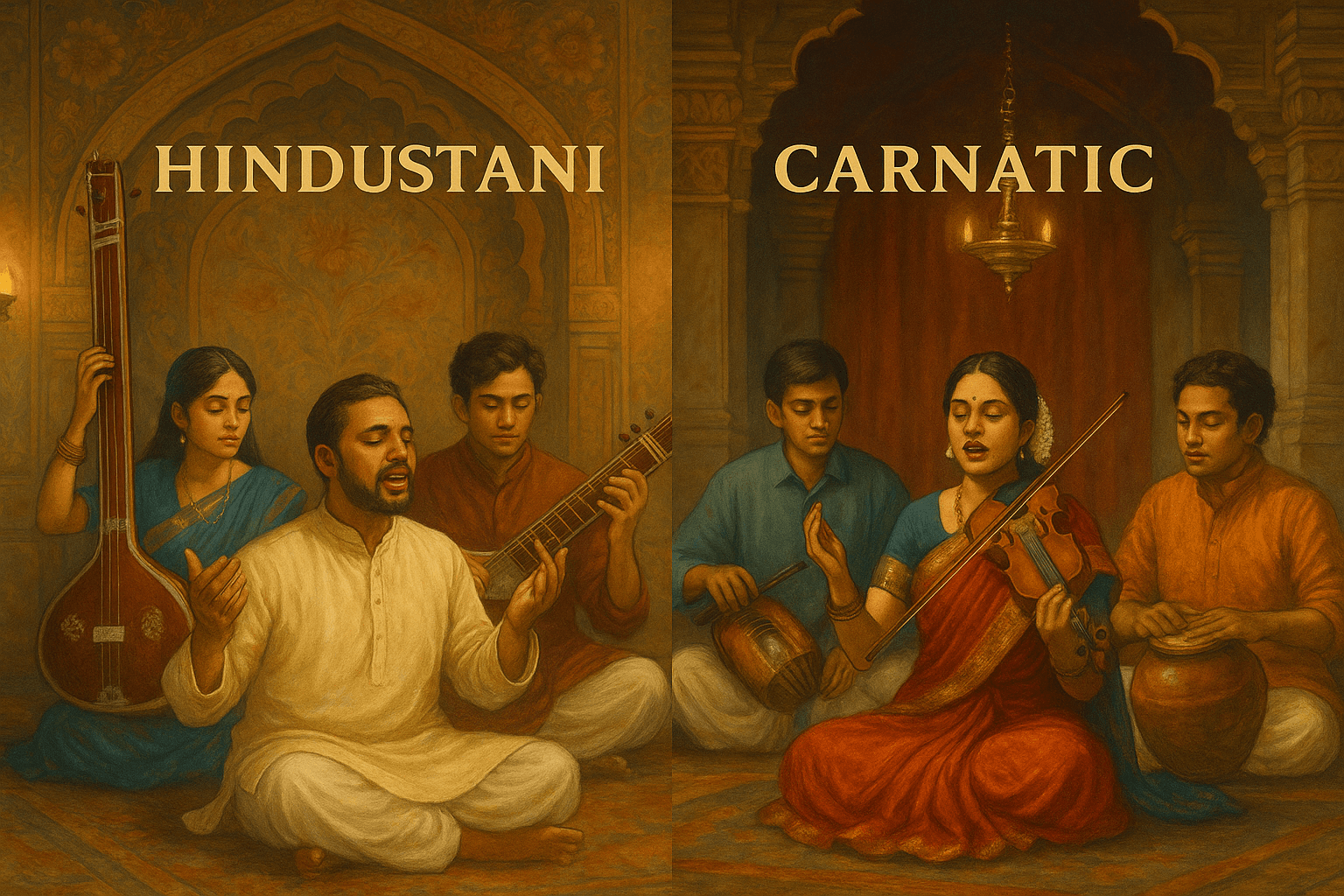 In performance format the Carnatic concert may follow a sequence of varnams, kritis and improvisation, often interspersed with complex rhythmic exchanges. The Hindustani concert may begin with an alaap followed by jor, jhala, bandish and taan sections. Accompaniment in each style differs: for instance the mridangam is central in Carnatic, while tabla and pakhawaj are hallmarks of Hindustani music. These differences in format, accompaniment and structure underscore the uniqueness of each style within the broader Indian music traditions.
In performance format the Carnatic concert may follow a sequence of varnams, kritis and improvisation, often interspersed with complex rhythmic exchanges. The Hindustani concert may begin with an alaap followed by jor, jhala, bandish and taan sections. Accompaniment in each style differs: for instance the mridangam is central in Carnatic, while tabla and pakhawaj are hallmarks of Hindustani music. These differences in format, accompaniment and structure underscore the uniqueness of each style within the broader Indian music traditions.
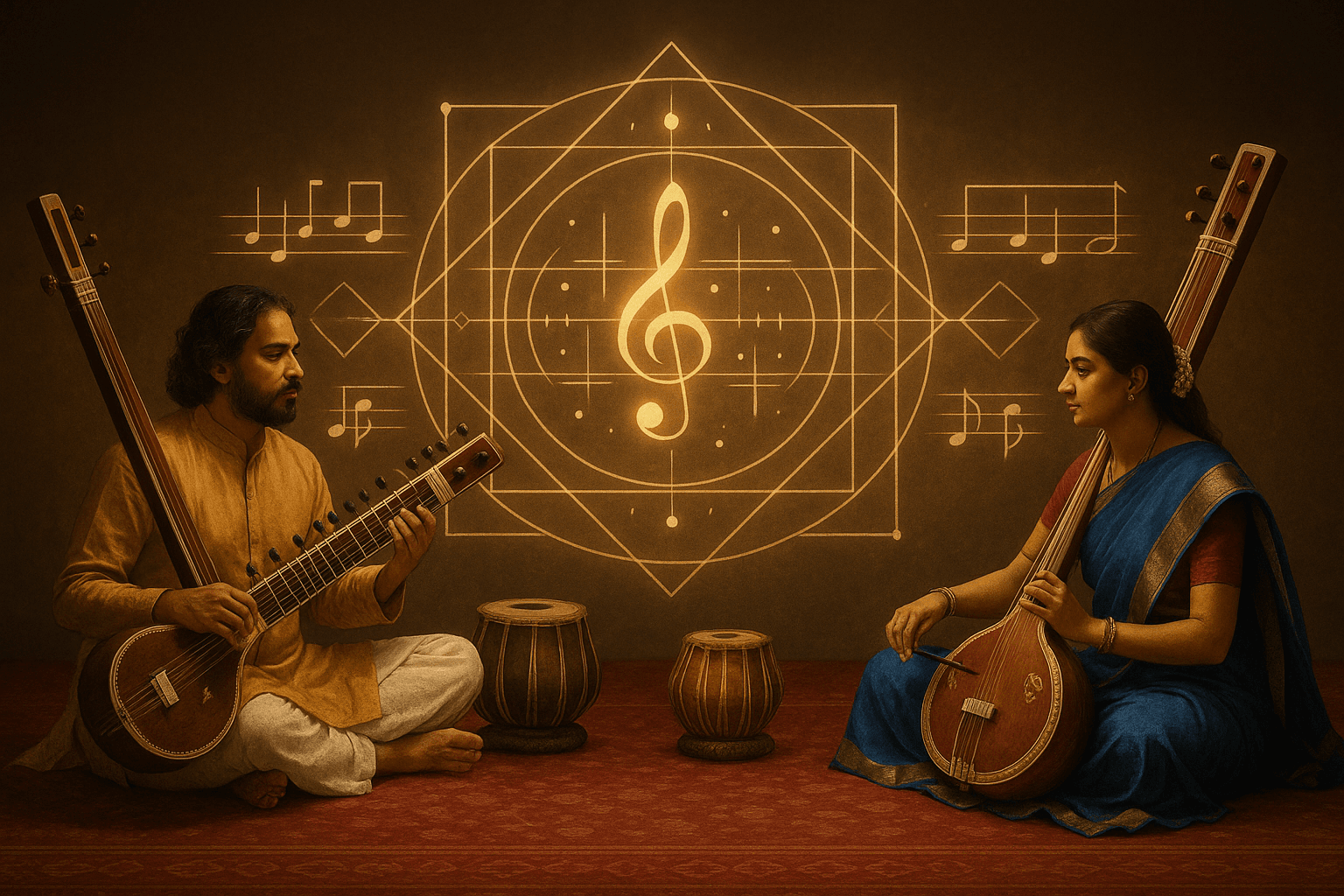 While the contrasts are many, the two traditions are bound by technical and structural parallels that reflect their shared heritage. Both rely on raga frameworks, tala cycles, bhava expression and a teacher-student lineage that spans centuries. These connections make the comparison between Hindustani and Carnatic not just a study of difference but a dialogue of unity.
While the contrasts are many, the two traditions are bound by technical and structural parallels that reflect their shared heritage. Both rely on raga frameworks, tala cycles, bhava expression and a teacher-student lineage that spans centuries. These connections make the comparison between Hindustani and Carnatic not just a study of difference but a dialogue of unity.
In both systems the triad of raga (melody), tala (rhythmic cycle) and bhava (emotional mood) forms the foundation for performance. Whether the artist in Hindustani music explores deep improvisation or the Carnatic musician navigates through a kriti with precision, these pillars remain constant. They anchor the listener in aesthetic experience and bind the traditions in more than mere coincidence.
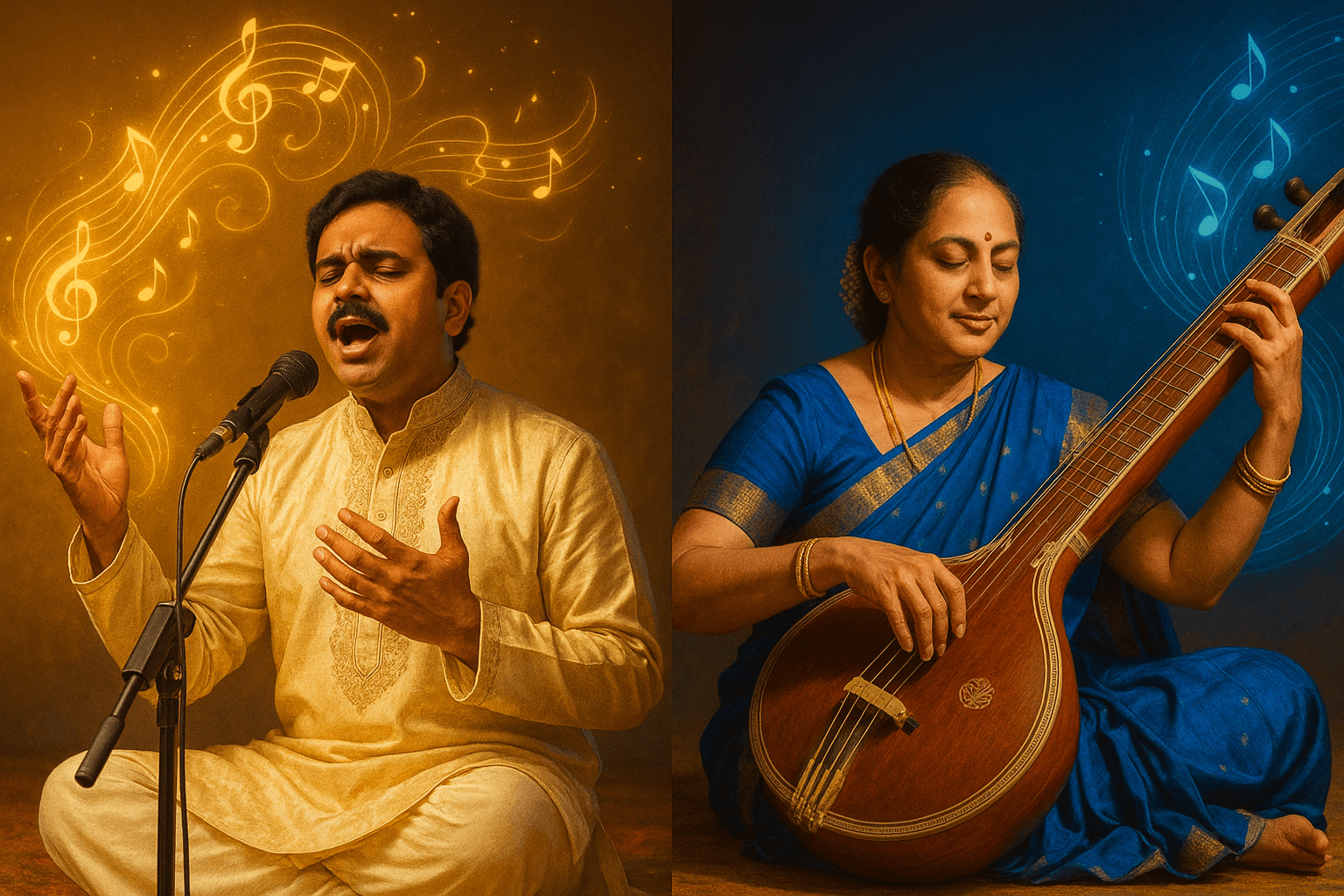 Improvisation in classical music is where the artist’s personality shines. In Hindustani classical music the improvisation may expand the raga for lengthy periods and highlight innovative taans. In Carnatic classical music improvisation is embedded in the composition: swara kalpana, neraval and ragam-tanam-pallavi showcase creative leaps within structure. Both reflect the same human urge to innovate, entertain and transcend.
Improvisation in classical music is where the artist’s personality shines. In Hindustani classical music the improvisation may expand the raga for lengthy periods and highlight innovative taans. In Carnatic classical music improvisation is embedded in the composition: swara kalpana, neraval and ragam-tanam-pallavi showcase creative leaps within structure. Both reflect the same human urge to innovate, entertain and transcend.
The educational processes in both traditions include written notations but rely heavily on oral transmission and practice. Notation in Hindustani music might capture bandish, taan or alaap cues; Carnatic notation may reflect kriti structure, tala patterns and gamakas. Yet both traditions keep alive the Guru-Shishya Parampara, the teacher-disciple system of deep musical immersion and lineage.
The tradition of Guru-Shishya Parampara remains vital across these Indian music styles. In both Carnatic and Hindustani styles the trainee lives with, learns from and absorbs the style of a master. Over years the student internalises the subtle expressive devices of voice modulation, rhythm cycles and melodic depth. This lineage ensures that artistry, improvisation and tradition continue to carry forward.
 If you, as a musician or learner in the USA, are wondering whether to choose Carnatic or Hindustani music, the decision involves personal, vocal and contextual factors. Both traditions have rich paths of learning, performance and personal growth. The choice ultimately depends on what suits your voice, your cultural connection, your goal and your learning context.
If you, as a musician or learner in the USA, are wondering whether to choose Carnatic or Hindustani music, the decision involves personal, vocal and contextual factors. Both traditions have rich paths of learning, performance and personal growth. The choice ultimately depends on what suits your voice, your cultural connection, your goal and your learning context.
Your vocal tone, your preference for improvisation or composition, your interest in ritual versus concert format all matter. If you enjoy exploring melody freely, then Hindustani classical music might appeal. If you prefer structured compositions, rhythmic precision and devotional lyrics, then Carnatic classical music may suit you. Listening carefully to both can help determine your fit.
Consider your access to teachers, your familiarity with regional languages (Tamil, Telugu for Carnatic; Hindi, Urdu for Hindustani), the type of concerts available, and your longer-term goal (performance, teaching, personal enjoyment). While neither style is inherently better, matching your environment, schedule and goal helps.
Beginners often find that structured pedagogy and clear compositions make Carnatic music accessible initially, while Hindustani’s improvisational demands may require more flexible practice. That said, motivated learners of any age can succeed in either tradition, especially when guided by good instructors and a consistent practice regime.
Both traditions offer paths to performance, teaching, composition, fusion music and global collaboration. International festivals, workshops and digital platforms increasingly spotlight both Hindustani and Carnatic classical music, allowing artists to reach global audiences. Understanding the professional ecosystem of either tradition helps learners find their niche.
Classical training in either tradition offers deep musical foundations that enrich modern genres: film music, fusion, jazz improvisation. Artists trained in Carnatic or Hindustani classical music often crossover into global music styles, drawing on the complexity of raga and tala, melodic improvisation, voice modulation and ornamentation to innovate.
The world of Indian classical music is vast yet interconnected. Though Carnatic and Hindustani classical music developed different expressions, they remain connected through shared foundations and musical philosophy. Their unity in diversity is a testament to India’s rich cultural heritage.
Carnatic music preserves temple traditions, devotional music and the melodic depth of South India while Hindustani classical music reflects courtly patronage, improvisation and cultural assimilation in the North. Together these traditions represent the full spectrum of the classical music of India.
Whether you lean toward Carnatic or Hindustani classical music, the most important thing is your passion, dedication and enjoyment. Choose the style that resonates with you, explore deeply and let the music become your guide—because in the end your voice and your heart will define your path more than tradition.
The main difference lies in their regional origin, approach to improvisation and structure. Hindustani classical music emphasises melodic freedom, improvisation and courtly roots, while Carnatic classical music follows structured compositions, devotion, and a more fixed framework of melodics and rhythms.
Neither tradition is inherently easier or harder; both require dedication. Carnatic music may demand greater precision in rhythmic cycles and composition recall, while Hindustani music might challenge one more in improvisation and melodic exploration. Your difficulty depends on your strengths and learning preferences.
Both stem from ancient Indian music forms such as those described in the Samaveda, but Hindustani classical music shows significant influence from Persian and Arabic traditions after the medieval period. Carnatic classical music remains more closely tied to older devotional traditions and temple music in South India.
The violin is widely used in Carnatic classical music as a primary melodic instrument and often supports vocalists in concerts. In Hindustani classical music the violin is also used, but instruments such as the sitar and sarod hold more central roles.